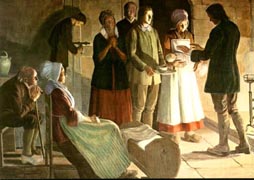
The Huguenot Cross

In spite of intense persecutions leading to the stake, and despite enforced banishment, Reformed congregations were set up all over France from 1555 onwards. Very soon, there were more that a thousand congregations with more than two million converts. The largest number of churches being in southern France. The Catholics and Protestant theologians met in the Poissy Colloquy (1561) attempting to find some common ground. Instead Protestantism was seen to be both a challenge to royal authority and a movement of conflicting faiths. Queen Catherine de Medici in 1562 did not take a strong stand against Protestants in France but other nobility used religious differences to cement their own local power.
"The Peace of St Germaine" in 1570 was the end of eight years of war surrounding the attempt by the Catholic League to consolidate power using religious differences as the leverage. Only two years later came the St. Bartholomew Day Massacre where more than 20,000 Huguenots were killed. Persecutions continued and were systematically carried out while whole cities transferred to Protestant control. In the South of France a kind of Protestant Republic was even declared in 1572, opposed to royal power, possessing an army and with its own legislature and government.
The Edict of Nantes of 1598 had given relative religious freedom
to the Huguenots by the sessession of the throne by Henry of
Navarre ( becoming Henry IV), a Huguenot. In England Calvinism
became known as the Puritans. The relative calm after the Edicts
of Nantes were broken periodically by constant pressure from the
Jansenist Catholics until the forcible take over of the Huguenot
strong hold of La Rochelle by Cardinal Richelieu's armies in 1628.
| The Protestants that remained with their faith were forced into secret worship ceremonies and endured constant alertness to avoid discovery. They disguised their pulpits as wine barrels or made them collapsible for easy concealment. They made miniature bibles that they hid easily including in the buns of women's hair. They hid their ministers in caves and secret compartments. The town of Anduze, just west of Alès, became the center of Protestant resistance under the leadership of the Duc de Rohan and were the most challenging of papal and the king's authority. The village had strong fortifications with rugged hills surrounding it. This allowed the Camisards group, as they were known, to hold off the kings army of 25,000 men for over two years after their initial attack in 1629. If they were discovered they were subjected to forced conversion. Unrepentant women were imprisoned in various chateau across France. Many men ended up chained to a galley oar on royal ships while others were simply killed. [Musee du désert] |
 "The Clandestine Baptism," by Jeanne Lombard, Musee du désert |
Louis XIV allowed the Huguenots some freedom from interference until he married the staunch Catholic, Madame de Maintenon 1684. He had been told that Protestantism had been eliminated from the country and, therefore, no need for the law. He revoked the Edicts of Nantes in 1685 and then took efforts at the forced conversion of any remaining members of the sects. Ministers of the faith were given two weeks to leave France while their congregation was denied the right to exit. If the ministers didn't leave they were arrested and forcibly removed from the country. Protestant reaction was swift. Since entire industries were controlled by the Huguenots and because their wealth and industry was important to the economy, it was very important to keep these people in France. Soldiers were stationed at the borders of France to prevent their emigration. They were then pushed back to their villages and forced to convert to Catholicism. Never the less, an estimated 300,000 people were able to get out of the country and took their money, skills and industry to the other countries which profited from these new immigrants. [Pigeaud ]
Our Brashears had probably gone to England about 1628 after Cardinal Richelieu's suppression at La Rochelle. Since their suppression campaign centered on Anduze, they could have very easily gone down the Rhone River from the Lyon or Alès regions to Marseille and picked up another boat there. (I personally favor this version without any firm facts to substantiate it.) If they were forced out at La Rochelle it would have been an easy trip from this port to go north along the coast and to cross the English Channel to Great Britain. England then was an ideal destination for this dispossessed group. By colonial association with Great Britain the leaders of Maryland, established in 1632, let it be known that they welcomed the Huguenots and other faiths. The second Lord Baltimore, Cecil Calvert, a Roman Catholic, believed in religious freedom and welcomed all settlers.
Benjamin Brashear is documented to have arrived in the Colonies from England in 1637 while Robert Brashear, his father, may have been here by 1636. They first settle in Virginia and gravitate to Maryland where he states in a document for citizenship that he had been previously a subject of the King of France. Several researchers have indicated that the immigrating Brassieur family had been residents of Avignon, in southern France. If they were in fact Calvinists in Avignon, it would give them good reason to leave since this was Catholic strong-hold since before the Renaissance. A ruin still exists in Avignon of the Pope's Palace created during the great schism.
See Robert Brasseiur and Benjamin Brashear
source:








All information and
photos included within these pages are here for the express
purpose of personal genealogical research and may not be
included or used for any commercial purpose or included in
any commercial site without the express permission of Cheryl
and Elroy Christenson. Copyright Elroy Christenson
1998-2016.